Imagine having a beautiful, low-maintenance plant that adds a touch of tropical elegance to your home. The lipstick plant, with its vibrant, tubular flowers, is a stunning addition to any room. As you consider adding a lipstick plant to your space, you’re not only bringing in a pop of color, but also a plant that’s easy to care for and can thrive in indoor conditions with proper lipstick plant care.

With its ability to improve indoor air quality and promote relaxation, the lipstick plant is a great choice for anyone looking to enhance their mental well-being. As an indoor plant, it’s perfect for those who want to bring a touch of nature into their home. By learning about the lipstick plant and its care, you can enjoy the many benefits it has to offer, from its beautiful flowers to its air-purifying properties, making it a great addition to your indoor plants collection.
Table of Contents
What is a Lipstick Plant?
The lipstick plant is a unique and fascinating species that belongs to the Gesneriaceae family. With approximately 150 species within the genus Aeschynanthus, this plant is known for its striking plant characteristics, including its green or purple, waxy leaves and its tubular red, orange, or yellow flowers. You can find various lipstick plant varieties, each with its unique features, such as the Aeschynanthus Mona Lisa and Aeschynanthus Black Pagoda.

The lipstick plant habitat is typically found in the tropical rainforests of Southeast Asia, where it grows as an epiphytic species in the lush canopies. To replicate this environment, you can provide your lipstick plant with medium to bright light and maintain a semi-moist soil condition. Here are some key plant characteristics to keep in mind:
- Leaf texture: Waxy or soft
- Flower color: Red, orange, yellow, or purple
- Growth habit: Epiphytic or terrestrial
Some popular lipstick plant varieties include the Black Pagoda Lipstick Plant, known for its mottled, variegated foliage, and the Cassiopeia Lipstick Plant, which produces bright red flowers from dark purple-red buds. By understanding the lipstick plant habitat and plant characteristics, you can provide your plant with the best possible care and enjoy its unique beauty.
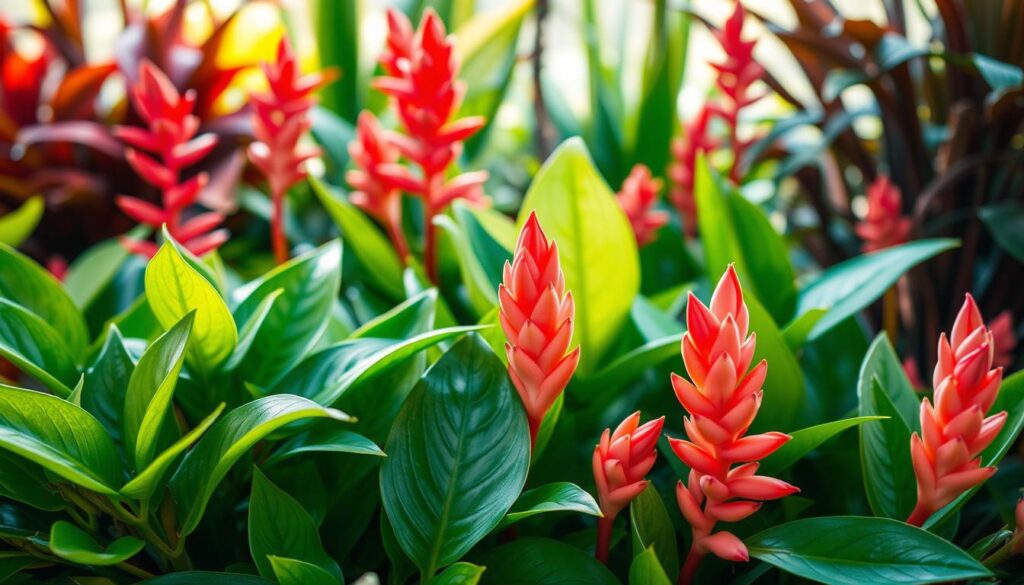
With proper care, your lipstick plant can thrive and produce beautiful flowers. Remember to fertilize your plant regularly and provide it with a well-draining potting mix to ensure optimal growth. By following these tips, you can enjoy the beauty of your lipstick plant and appreciate its unique plant characteristics.
| Variety | Leaf Color | Flower Color |
|---|---|---|
| Aeschynanthus Mona Lisa | Dark Green | Red-Orange |
| Aeschynanthus Black Pagoda | Mottled, Variegated | Red, Orange |
Benefits of Growing a Lipstick Plant
As you consider adding a Lipstick Plant to your home, you may be wondering what benefits it can bring. One of the most significant advantages of having a Lipstick Plant is its role in air purification. Like many other plants, it absorbs carbon dioxide and releases oxygen, but it also has the capability to remove certain toxins from the air, contributing to a healthier indoor air quality.
In addition to its air purification capabilities, the Lipstick Plant is also known for its aesthetic appeal. Its cascading vines and vibrant flowers add a touch of elegance to any room, making it a great choice for those looking to enhance the beauty of their home. Some of the benefits of having a Lipstick Plant include:
- Improved indoor air quality through the removal of toxins and pollutants
- Enhanced aesthetic appeal with its vibrant flowers and trailing vines
- Promotion of a healthier environment through the release of oxygen and absorption of carbon dioxide
As an aesthetic plant, the Lipstick Plant can be used to add a touch of beauty to any room. Its unique flowers and trailing vines make it a great choice for hanging baskets or pots, and its ability to thrive in a variety of lighting conditions makes it a versatile option for any home. With its air purification capabilities and aesthetic appeal, the Lipstick Plant is a great choice for anyone looking to improve the indoor air quality and beauty of their home.
How to Care for Your Lipstick Plant
To keep your Lipstick Plant thriving, it’s essential to understand its specific needs. When it comes to lipstick plant care, lighting is a crucial factor. The plant prefers bright, filtered light, making an east or north-facing window an ideal location. Direct sunlight can be too intense and may cause the leaves to become scorched.
Another critical aspect of plant lighting is the temperature. The ideal temperature for a Lipstick Plant is between 65-75 degrees Fahrenheit, which aligns with typical household temperatures. In terms of watering plants, the soil should be kept moist but not soggy. Allow the top few inches of soil to dry out between waterings to prevent root rot.
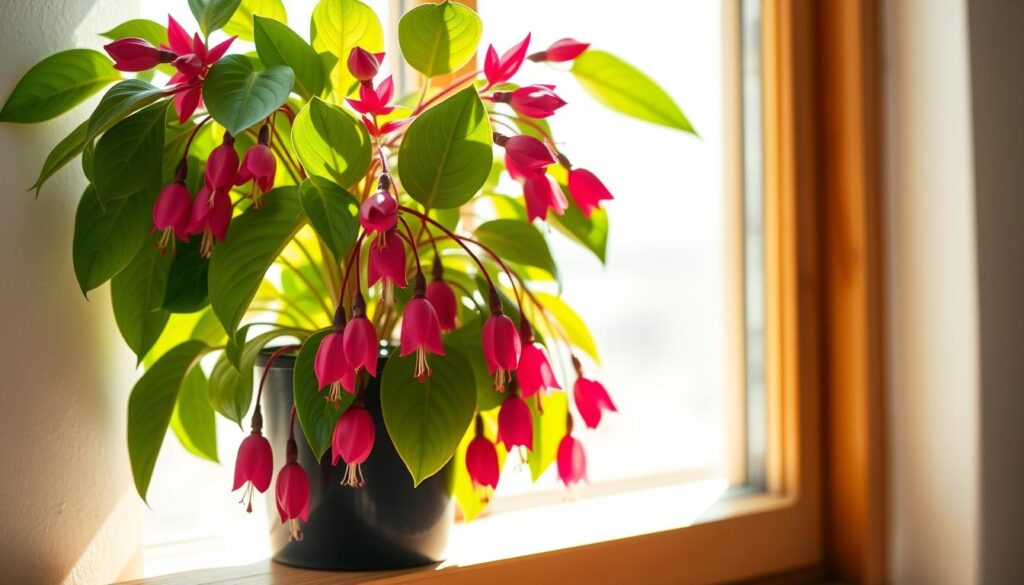
For optimal growth and blooming, fertilization is necessary during the growing season (spring through early fall). A balanced, water-soluble fertilizer diluted to half strength and applied twice a month is recommended. By following these lipstick plant care tips, you can enjoy the beauty of your Lipstick Plant and keep it healthy and thriving.
Common Pests and Diseases
As you care for your Lipstick Plant, it’s essential to be aware of common pests and diseases that can affect its health. Regular inspection of your plant is crucial in identifying potential issues early on, allowing for prompt action to prevent the spread of plant pests and plant diseases.
Some common pests that can infest your Lipstick Plant include aphids, mites, and mealybugs. These pests can cause damage to the plant’s leaves and flowers, leading to a decline in its overall health. To prevent infestations, it’s vital to maintain good air circulation and avoid overwatering, which can attract plant pests. Implementing pest control measures, such as neem oil or insecticidal soap, can help eliminate these pests if they do appear.
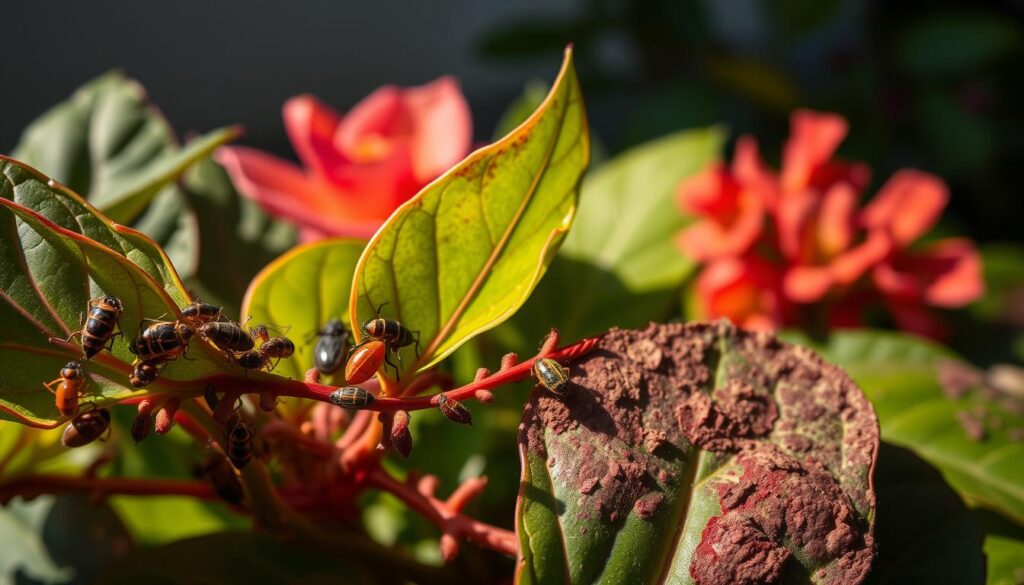
In addition to pests, your Lipstick Plant can also be susceptible to various plant diseases, including root rot, leaf spot, and powdery mildew. These diseases can be caused by overwatering, poor air circulation, or contaminated soil. To prevent the spread of disease, it’s crucial to maintain a healthy environment for your plant, including proper watering techniques and good air circulation. By taking these preventive measures, you can help protect your Lipstick Plant from common pests and diseases, ensuring it remains healthy and thriving.
Preventive Measures
- Regularly inspect your plant for signs of pests or disease
- Maintain good air circulation to prevent the spread of disease
- Avoid overwatering, which can attract pests and cause disease
- Implement pest control measures, such as neem oil or insecticidal soap, if necessary
By following these preventive measures, you can help keep your Lipstick Plant healthy and pest-free, allowing it to continue thriving and adding beauty to your home.
Propagation Methods for Lipstick Plants
As you explore the world of lipstick plants, you may want to share these beautiful plants with friends or expand your own collection. Plant propagation is an exciting way to do this, and one of the most common methods is through stem cuttings. To propagate a lipstick plant using stem cuttings, take 4-6 inch cuttings from healthy stems, remove the lower leaves, and place the cuttings in water or a moist potting mix until roots develop.
Another method of propagation is division techniques, which involves separating the plant into sections, each with its own roots, and potting them separately. This method is best done when the plant is becoming pot-bound and needs to be repotted. For successful rooting, it’s essential to provide the right conditions, including temperatures above 70°F (21°C) and high humidity.
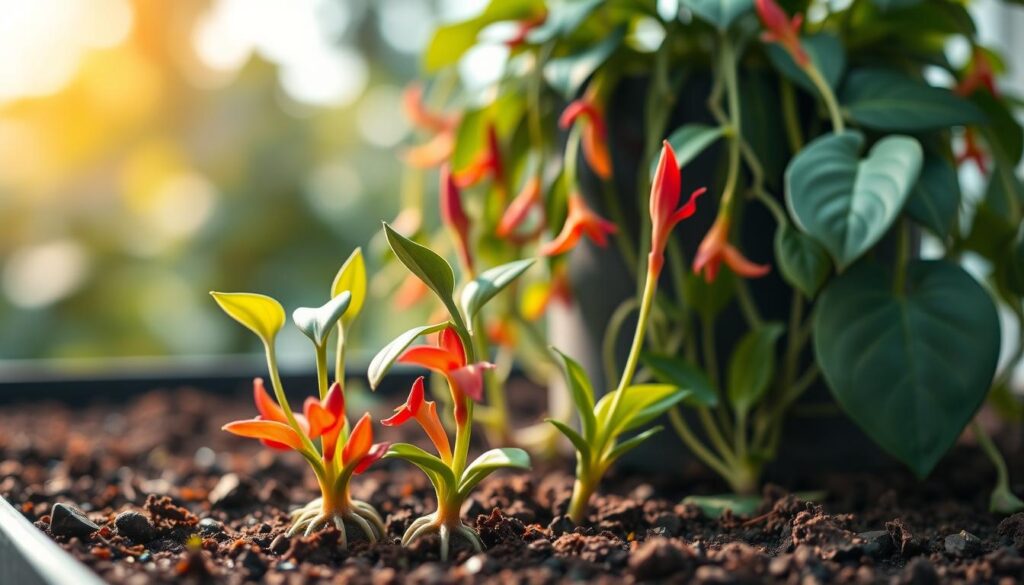
- Use healthy stems for stem cuttings
- Provide the right conditions for root development, including temperature and humidity
- Use a low-nutrient and loose substrate for propagation
- Keep the soil slightly moist without allowing the plant to sit in standing water
By following these tips and using the right division techniques, you can successfully propagate your lipstick plant and enjoy its beautiful flowers and vines. Remember to keep the temperature between 65°F to 80°F and maintain a tropical environment without excessive dampness for optimal growth.
| Propagation Method | Success Rate | Time to Root |
|---|---|---|
| Stem Cuttings | 60% | 4-6 weeks |
| Division Techniques | 80% | 2-3 months |
Ideal Growing Conditions
To create an optimal environment for your Lipstick Plant, it’s essential to understand the ideal growing conditions. This includes soil requirements that mimic the plant’s natural habitat. A well-draining potting mix that includes perlite and sand is ideal, as it prevents water from accumulating in the soil and reduces the risk of root rot.
In terms of temperature preferences, Lipstick Plants thrive in temperatures between 18-24°C (65-75°F). It’s crucial to keep the plant away from drafts and sudden temperature changes, which can cause stress. By providing the right growing conditions, you can help your Lipstick Plant flourish and enjoy its beautiful flowers and foliage.
Some key factors to consider when creating an ideal environment for your Lipstick Plant include:
- Using a well-draining potting mix
- Maintaining temperatures between 18-24°C (65-75°F)
- Providing bright, indirect light
- Maintaining a humid environment, ideally between 50-70%
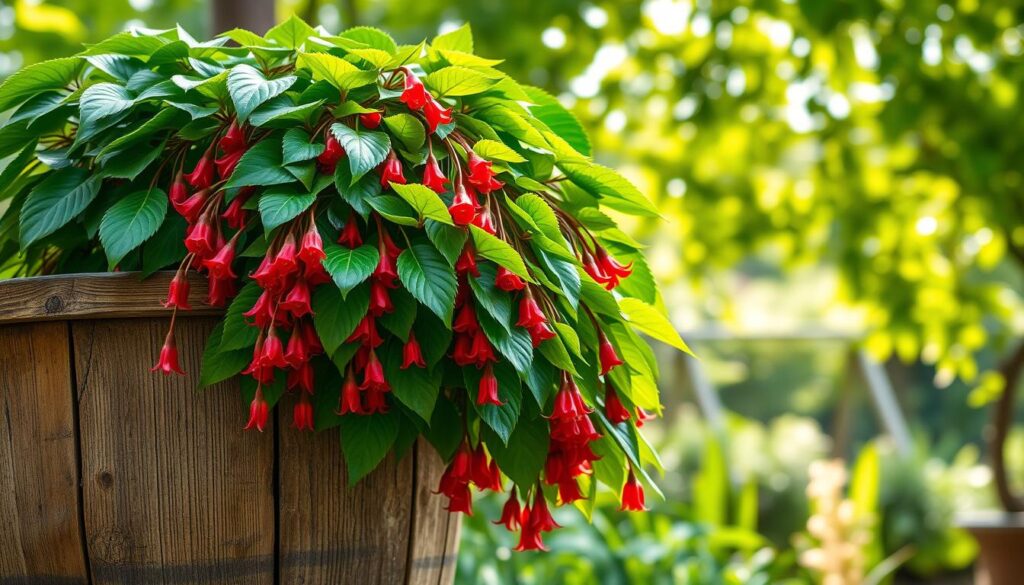
By following these guidelines and providing the right growing conditions, you can help your Lipstick Plant thrive and enjoy its many benefits, including air purification and aesthetic appeal.
Lipstick Plant in Home Décor
When it comes to incorporating the Lipstick Plant into your home decor, the possibilities are endless. This versatile plant can thrive in a variety of settings, from modern apartments to traditional homes. To create a stunning display, consider pairing the Lipstick Plant with other plants that complement its trailing vines and vibrant flowers.
In terms of indoor gardening, the Lipstick Plant is a great choice for those looking to add a touch of elegance to their space. Its ability to cascade down from hanging baskets or wall sconces makes it a perfect addition to any room. For a cohesive look, try pairing the Lipstick Plant with other tropical plants, such as ferns or peace lilies, to create a lush and exotic atmosphere.
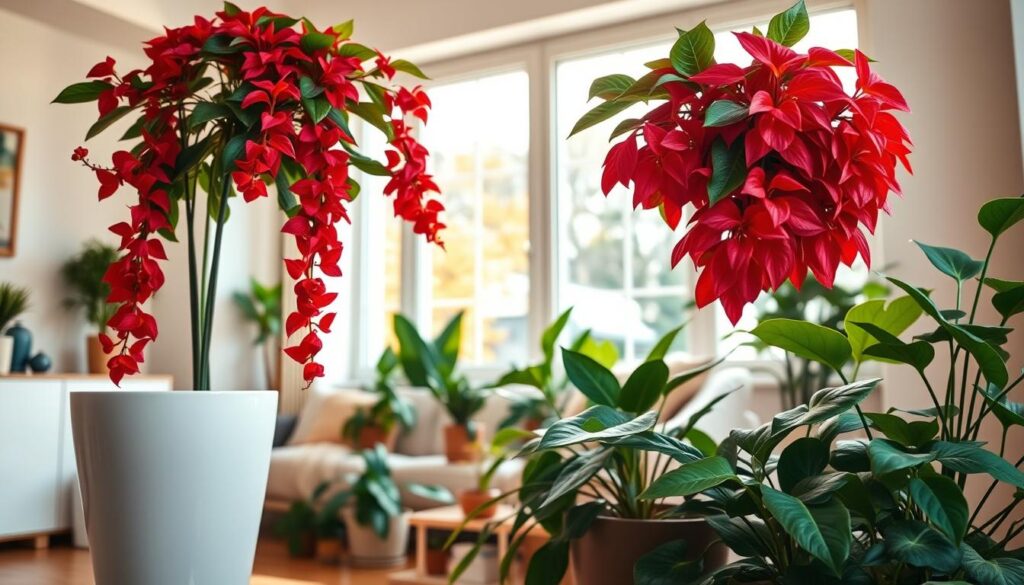
Some creative ways to display the Lipstick Plant in your home decor include:
- Hanging baskets: Allow the plant’s trailing vines to cascade down for a beautiful display
- Wall sconces: Showcase the plant’s vibrant flowers and add a touch of elegance to any room
- High shelves: Place the plant on a high shelf to create a stunning display and add depth to the room
By incorporating the Lipstick Plant into your home decor, you can create a unique and stunning display that showcases your personal style. With its versatility and ease of care, this plant is perfect for anyone looking to add a touch of elegance to their space. Whether you’re a seasoned indoor gardening enthusiast or just starting out, the Lipstick Plant is a great choice for anyone looking to create a beautiful and thriving indoor garden.
Troubleshooting Common Issues
As you care for your Lipstick Plant, you may encounter some common plant problems. Two of the most frequent issues are yellowing leaves and dropping flowers. To address these problems, it’s essential to understand their causes and take corrective action.
Yellowing leaves can be a sign of overwatering or insufficient light. If you notice your plant’s leaves turning yellow, check the soil moisture and adjust your watering schedule accordingly. Also, consider moving the plant to a brighter location to provide it with more light.
Dropping flowers can be disappointing, but it’s often a natural part of the plant’s cycle. However, if your plant is not producing flowers, it might be due to lack of light or fertilization. Ensure your plant is receiving sufficient light and consider applying a balanced fertilizer to promote blooming.
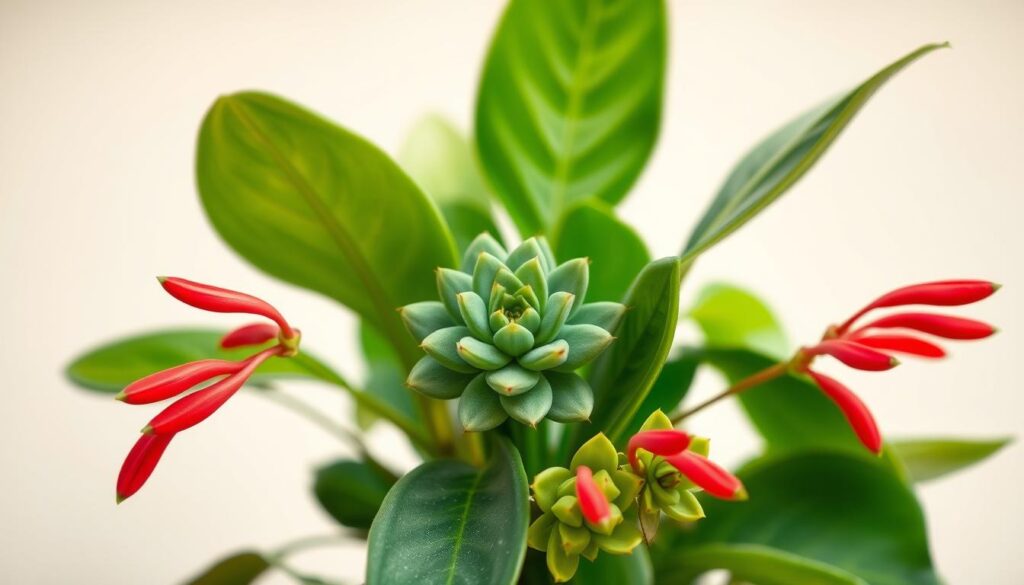
- Allow the top 2 inches of soil to dry out before re-watering
- Provide bright, indirect light
- Fertilize every four waterings in spring and summer
| Issue | Cause | Solution |
|---|---|---|
| Yellowing leaves | Overwatering or insufficient light | Adjust watering schedule and provide more light |
| Dropping flowers | Lack of light or fertilization | Provide sufficient light and fertilize regularly |
Seasonal Care for Lipstick Plants
As you continue to care for your Lipstick Plant, it’s essential to consider the changing seasons and how they impact your plant’s needs. Seasonal care is crucial to ensure your plant remains healthy and thriving throughout the year.
In the summer, your Lipstick Plant is in its active growth phase, requiring more water and fertilization to support its growth and blooming. Providing sufficient light is also essential, as the longer days of summer can stimulate more vibrant blooms. On the other hand, during the winter, your plant goes into a dormant phase, requiring less water and fertilization. It’s crucial to reduce watering to prevent root rot and maintain a cooler temperature to simulate the plant’s natural winter period.
Here are some tips for summer care and winter care:
- Water your plant when the top 1 inch of soil dries out in the summer, and reduce watering to once a month in the winter.
- Fertilize your plant every 2-4 weeks during the growing season, and reduce fertilization to every 6-8 weeks in the winter.
- Provide sufficient light, but avoid direct sunlight, which can cause leaf scorch.
By following these seasonal care tips, you can ensure your Lipstick Plant remains healthy and thriving throughout the year. Remember to adjust your care routine according to the season, and don’t hesitate to reach out if you have any questions or concerns.
| Season | Watering | Fertilization |
|---|---|---|
| Summer | Water when top 1 inch of soil dries out | Fertilize every 2-4 weeks |
| Winter | Reduce watering to once a month | Reduce fertilization to every 6-8 weeks |
Frequently Asked Questions About Lipstick Plants
As you’ve learned, the vibrant and unique Lipstick Plant can make a delightful addition to your home. But before you bring one home, there are a few common questions you may have. Let’s address a couple of the most frequently asked queries about caring for your Lipstick Plant:
How often should I water my plant?
The Lipstick Plant enjoys consistently moist soil, but you’ll want to avoid letting it become waterlogged. During the growing season, water your plant about once a week, allowing the top few inches of soil to dry out slightly between waterings. In the winter months, cut back on watering, aiming to water every two to three weeks.
Can lipstick plants thrive indoors?
Yes, with the right care, Lipstick Plants can absolutely thrive indoors. They prefer bright, filtered light, so place them near a sunny window. Maintain consistent moisture and humidity levels, and fertilize every two weeks during the spring and summer. With these simple steps, you can enjoy the vibrant, trailing blooms of a Lipstick Plant even in an indoor setting.
FAQ
How often should I water my Lipstick Plant?
You should keep the soil consistently moist but not soggy, allowing the top few inches of soil to dry out between waterings.
Can Lipstick Plants thrive indoors?
Yes, with the right care, including bright, filtered light, consistent watering, and proper fertilization, the Lipstick Plant can not only survive but flourish in indoor conditions.
What are some common pests that affect Lipstick Plants?
Common pests include aphids, mites, and mealybugs, which can be treated with neem oil or insecticidal soap if detected early.
How do I propagate a Lipstick Plant?
The most common methods of propagation are through stem cuttings and division. Take 4-6 inch cuttings from healthy stems, remove the lower leaves, and place the cuttings in water or a moist potting mix until roots develop.
What type of soil does a Lipstick Plant prefer?
A well-draining potting mix that includes perlite and sand is ideal for the Lipstick Plant, as it prevents water from accumulating in the soil and reduces the risk of root rot.
Source Links
- The Complete Lipstick Plant Grow and Care Guide – https://thursd.com/articles/lipstick-plant-grow-and-care-guide
- Mona Lisa Lipstick Plant | Pucker Up Baby! | Care Difficulty – Easy – https://nouveauraw.com/indoor-plants/varieties/mona-lisa-lipstick-plant-pucker-up-baby/
- Cafe Planta – https://cafeplanta.com/a/blog/the-astonishing-benefits-of-lipstick-plant-unveiling-its-beauty-secrets
- Lipstick Plant – https://costafarms.com/blogs/plant-finder/lipstick-plant?srsltid=AfmBOoq85V0hBee2Ce4A0XUz6o28fJ4GEa8WQZNVPw_o324CAi4A0SAL
- Aeschynanthus – https://en.wikipedia.org/wiki/Aeschynanthus
- How to Care for Lipstick Plants | Gardener’s Supply – https://www.gardeners.com/how-to/lipstick-plant-care/9729.html?srsltid=AfmBOor3fkHiskoEpfUuvP4xIVdNc_2XSiSZV1_tyF-5JCbdKUZZhpUa
- 10 Benefits of Having a Lipstick Plant – https://greg.app/lipstick-plant-benefits/
- Lipstick plant. See the Amazing plant blossoms – Eduyush – https://www.eduyush.com/blogs/plant-care/lipstick-plant?srsltid=AfmBOorwFxs2Z-GD8i1O29GaaQUGROpI3gTDAe_QSLV4mVJCJ6QtlO7V
- Care Guide for the Lipstick Plant — The Green Mad House – https://thegreenmadhouse.com/plants/care-guide-for-the-lipstick-plant
- How to Grow Lipstick Plant: The Striking Houseplant You Need for a Pop of Color – https://www.thespruce.com/lipstick-plant-care-5083734
- How to grow and care for a lipstick plant – https://www.gardenersworld.com/house-plants/lipstick-plant-aeschynanthus/
- 🐛 What To Do About Bugs on My Lipstick Plant? – https://greg.app/bugs-on-lipstick-plant/
- Cafe Planta – https://cafeplanta.com/a/blog/common-lipstick-plant-diseases-causes-symptoms-and-treatments
- Lipstick Plant Propagation: 2 Simple & Effective Methods – https://www.ohiotropics.com/2021/04/08/lipstick-plant-propagation/
- Lipstick plant: care, propagation & species – Plantura – https://plantura.garden/uk/houseplants/lipstick-plant/lipstick-plant-overview
- How Do I Propagate My Lipstick Vine? – https://greg.app/propagate-lipstick-vine/
- How to Grow and Care for Lipstick Vines | Gardener’s Path – https://gardenerspath.com/plants/houseplants/grow-lipstick-vine/
- How to Care for Lipstick Plants | Gardener’s Supply – https://www.gardeners.com/how-to/lipstick-plant-care/9729.html?srsltid=AfmBOorwFNSI9uLe8Zey3Ay7RV9_onml-Iv0vSa772IGn-Ir9S1Xly3C
- How to Care for Lipstick Plant – https://hicksnurseries.com/how-to-care-for-lipstick-plant/
- How to Care for Lipstick Plants | Gardener’s Supply – https://www.gardeners.com/how-to/lipstick-plant-care/9729.html?srsltid=AfmBOoq572ZOjUenQtpTC8xfIn4Qoo4XCh5raM9Klij8XzjEmhx7bl-N
- Lipstick Plant – How To Grow And Care For Them – https://bloomboxclub.com/blogs/news/lipstick-plant-how-to-grow-and-care-for-them
- Our Cheatsheet for Lipstick Plants! (Aeschynanthus) – https://www.ukhouseplants.com/plants/aeschynanthus-lipstick-plants
- Common Lipstick Plant Problems – https://greg.app/lipstick-plant-problems/
- Common Twisted Lipstick Plant Problems – https://greg.app/twisted-lipstick-plant-problems/
- How to Care for Lipstick Plants | Gardener’s Supply – https://www.gardeners.com/how-to/lipstick-plant-care/9729.html?srsltid=AfmBOoqJ3M2P-a3zRXInBxGoJhxj-OMUf8tiay269m1nOL00I6l-1oO-
- Lipstick Plants for Sale – Buying & Growing Guide – Trees.com – https://www.trees.com/house-plants/lipstick-plant
- Guide to Growing Aeschynanthus Radicans, the Lipstick Plant – https://36vine.com/blogs/lipstick-plant/
- How to Plant, Grow and Care For Lipstick Plants – https://www.epicgardening.com/lipstick-plant/


1 thought on “Vibrant Lipstick Plant: Add a Pop of Color to Your Home”